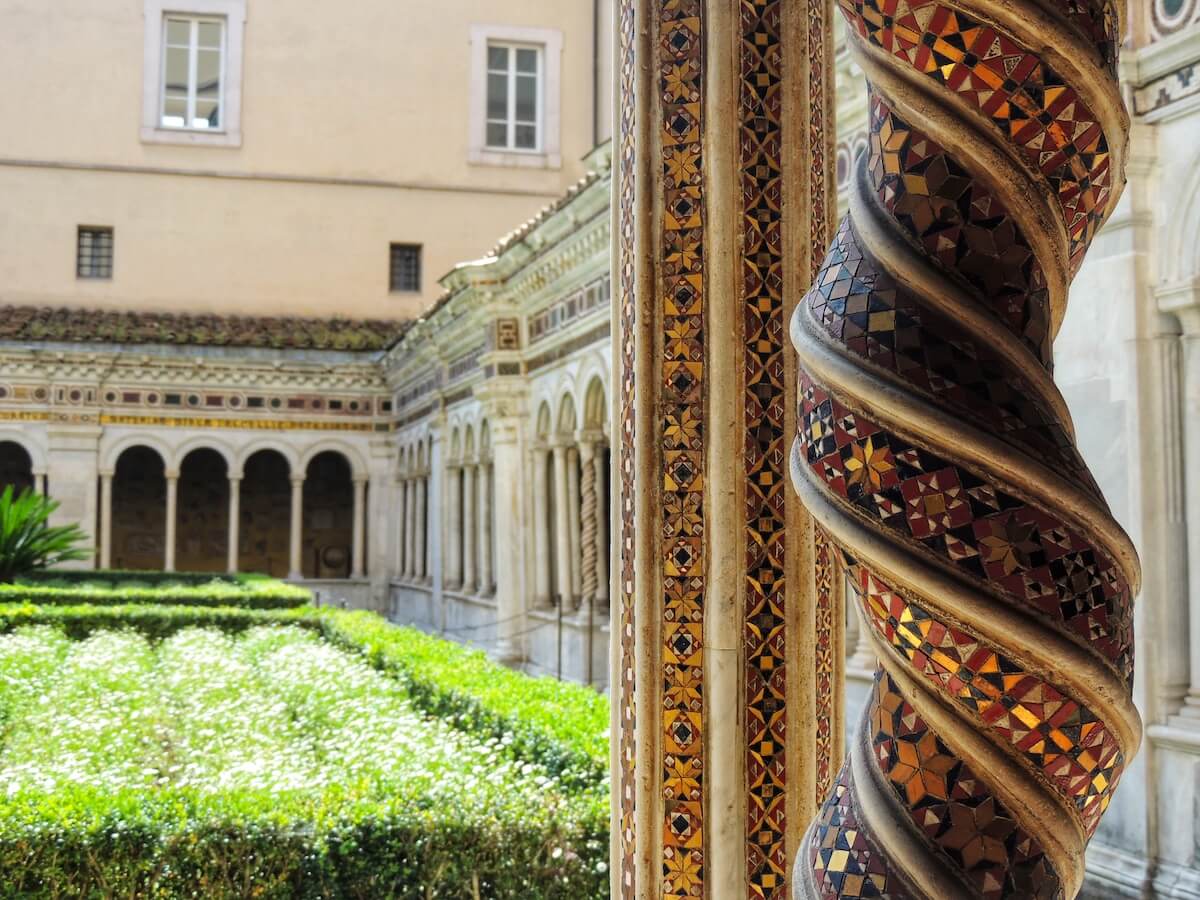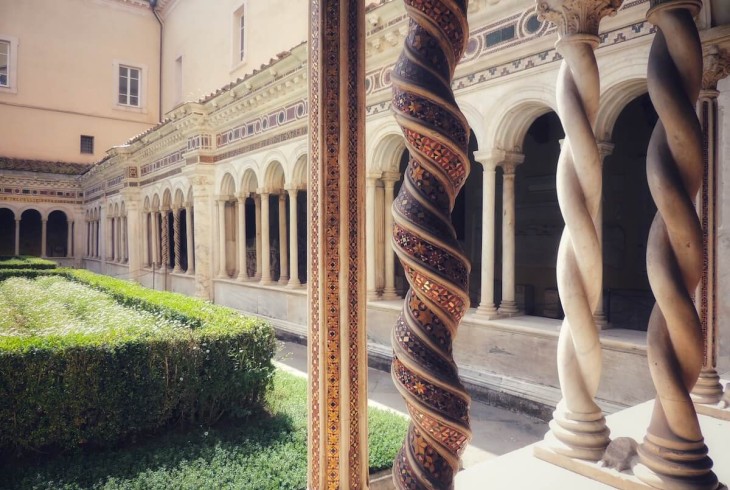Rome might be our favourite city in the world, but we’d be the first to admit that things can be a little, er, chaotic in Caput Mundi. Glittering artworks, fountains and palaces are everywhere you look; an endless stream of vespas, smart cars and three-wheelers scream down every alley and boulevard; the powerful aromas of Roman cuisine emanate from the city’s legion of restaurants at all hours of the day and night; and most of all, there are people, people everywhere. Yes, for all its splendour and all its charm, the Eternal City is an all out assault on the senses that can overwhelm even the most seasoned of travellers.
But that’s not to say that you can’t find a little slice of tranquillity amidst the bustle - if you know where to look that is! When things get a little much for us in Rome, our go-to strategy is to slip into one of the hundreds of freely accessible churches that lie around every corner of the city. In many, often hidden away at first sight, you’ll find wonderfully peaceful cloister gardens where you can settle back and recharge your batteries, with only the sound of church bells and warbling birds for company. Here are seven of our favourite cloisters in Rome!
San Giovanni in Laterano

One of Rome's true hidden gems, San Giovanni in Laterano's 13th-century cloister offers a window into the glittering world of medieval artistry with few equals. The brainchild of the father and son duo Pietro and Niccolò Vassalletto, the perfectly square cloister is rich in stunning Cosmatesque detailing. Covered arcades run along the four sides, with delicate spiralling columns opening onto the central garden. A contemporary inscription recalls the timeless undertaking of its craftsmen: "Noble and learned in craft, Vassalletto began this work with his father, which he finished alone." If you're ever lucky enough to visit the cloister, its tranquillity will surely stay with you forever, a wonderful gift from its medieval creators to posterity.
Santa Maria della Pace

Nobody had a bigger hand in bringing the Renaissance to Rome than architect Donato Bramante, a bitter rival of Michelangelo. Besides being tasked with designing new St. Peter’s basilica and coming up with the first circular church to be built since antiquity at San Pietro in Montorio, Bramante also used his formidable skills and grasp of proportion to create a series of stunning courtyards in private palaces and religious institutions across the city.
One of the finest is the cloister adjoining the church of Santa Maria della Pace in downtown Rome. Commissioned by the powerful Cardinal Oliviero Carafa, the square cloister was originally the centrepiece of a monastic complex, and unfolds across two levels. The lower level comprises an arcaded portico featuring delicate Ionic columns, whilst the open-air upper gallery is divided by Corinthian pilasters and columns. The beautiful courtyard perfectly showcases Bramante’s knowledge of ancient architecture and his ability to synthesise it into a new language of light, space and harmony that would soon become one of the most identifiable features of Renaissance Italy.
Today Bramante’s cloister is part of an exhibition space featuring major shows throughout the year. The upper gallery is given over to a lovely cafe - the perfect spot to unwind after a day exploring central Rome. Keep a look out too for Raphael’s Sibyl frescoes in the church next door, which are visible from a viewing platform in the cafe’s inner room.
San Paolo fuori le Mura

San Paolo le Mura is one of Rome’s most venerable churches, founded in the time of Constantine to mark the legendary site of St. Paul’s tomb. The interior is well worth a visit in its own right, but when here make sure to duck into the spectacular early 13th-century cloister of the adjacent monastery, another masterpiece of medieval craftsmanship gifted to us by the Vassalletti family.

A round-arched arcade of slender, delicately carved columns joined in pairs runs along all four sides of the central garden, where rose bushes, hedges and palm trees complete the idyllic scene. Take a closer look at the columns and marvel at their infinite variety: some spiral like thick tresses of braided hair, whilst others are inlaid with stunning Cosmatesque mosaic-work. Above, relief carvings depict overtly religious subjects like Adam and Eve alongside more ambiguous sculptures of sphinxes, three-headed kings and other mythical beings. It’s a beautiful spot to stop and meditate, accompanied only by the cooing of doves and the odd peal of the bells from the nearby campanile.
Santi Quattro Coronati

The fortified monastic complex of Santi Quattro Coronati is a maze-like jumble of chapels, dormitories and courtyards surrounding the eponymous church, built in the early 12th century under the patronage of Pope Paschal II after an earlier basilica was burned to the ground by Norman invaders in 1084. Penetrate into the deepest recesses of the complex and eventually you’ll emerge blinking into the sunlight of its early-13th century cloisters, reputed by many to be the most peaceful in Rome.
Designed by the Cosmati, a renowned family of medieval artists known to posterity for their virtuoso use of a marble inlay technique known as Cosmatesque in their honour, the rectangular cloister features walkways on all four sides chock-full of ancient and medieval carvings and inscriptions - the products of thousands of years of restorations and re-buildings that have taken place here. The slender paired columns hold up a series of round arches, and you can still see the remains of medieval frescoes decorating their undersides. The walkways surround a central garden, where a squat fountain sits in a shallow pool
Santa Maria degli Angeli

Converted from the remains of the massive ancient Roman Baths of Dicoletian, the sprawling religious complex of Santa Maria degli Angeli was designed by none other than Michelangelo in one of the final acts of his long career. Surrounding the church itself, which was hewn from the central hall of the mighty baths, are the grounds of a Carthusian monastery - today home to part of Rome’s Museo Nazionale.
At the centre is the truly enormous Great Cloister, also traditionally ascribed to Michelangelo, around which the cells of the hermit monks were arrayed. The whitewashed arcades and ochre tiled roofs confer a spiritual simplicity on the space, whilst hundreds of ancient sculptural and architectural fragments dot the lawns. Look out for some truly extraordinary animal heads, including a trumpeting elephant and a pair of colossal oxen who guard one of the cloister’s central walkways. Alongside a deer and a ram which you can also see in the cloister, they are the sole survivors of the incredible decorations that once adorned the mighty Temple of the Deified Trajan.
Sant’Andrea delle Fratte

An oasis of calm just yards away from the frenetic bustle of the Spanish Steps, the peaceful cloister garden of Sant’Andrea delle Fratte is characterised by the orange and loquat trees hanging heavy with fruit that provide welcome shade even in the height of summer. The cloister forms part of a convent belonging to the 15th-century Minim order, and is accessed via the right-hand transept of the church.
Fish carp merrily in a central fountain taking the form of a lichen-covered rock and, adding to the peaceful feeling, you’ll frequently hear the harmonious strains of violins and cellos emanating from the halls of a music academy located to one side of the cloister. Look out for the lunettes of the archways that surround the cloister garth, decorated with fine 17th-century frescoes depicting the miracles performed by San Francesco di Paola, the founder of the Minim order.
San Carlo alle Quattro Fontane

Ask any architecture buff for their favourite places in Rome, and Francesco Borromini’s extraordinary, diminutive church of San Carlo alle Quattro Fontane is likely to be near the top of the list. The entire façade of this tiny church could fit inside a single supporting pier of St. Peter’s enormous dome, and yet entering San Carlino remains a dizzying experience. Shapes morph into one another. A convex curve suddenly becomes concave, and it is impossible to determine exactly how or when the transformation took place. Borromini sculpted with space, dematerialising his architectural constructions in a way few architects had attempted before or since.
Equally dizzying is San Carlino’s little cloister, reached via a passageway at the back of the church. It’s not easy to determine exactly what shape the two-storey cloister takes, as the constantly shifting walls are bevelled at the edges and perforated with arches, creating a subtle but continuous sense of movement. At the centre, an octagonal well provided the Trinitarian friars who lived here with a ready supply of fresh water.
Through Eternity Tours offer award-winning, expert led itineraries in Rome. From the jaw-dropping highlights of the Vatican Museums and the Colosseum to off-the-beaten-path gems that only locals know, join our small-group and private tours of Rome to discover the Eternal City at its best.




